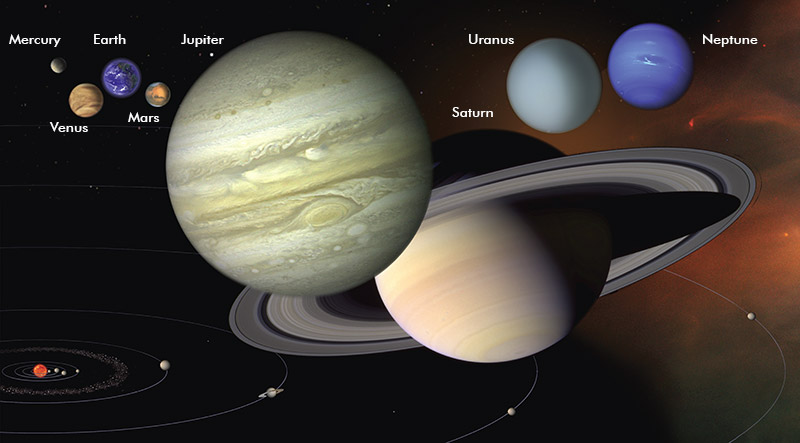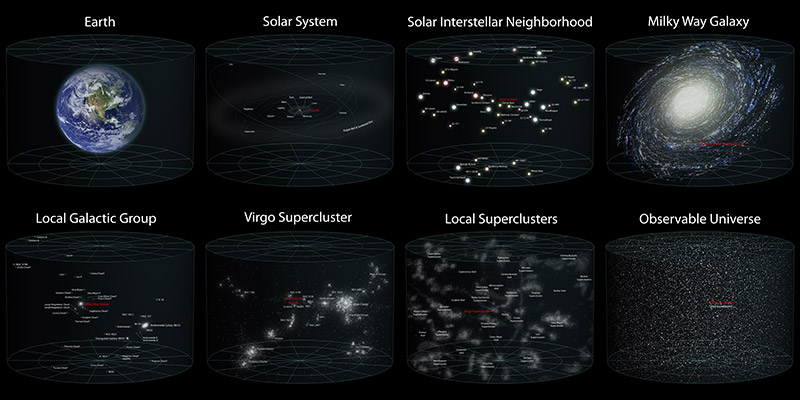Solar System
Humans have gazed at the heavens and tried to understand the cosmos for thousands of years. Ancient civilizations placed great emphasis on careful astronomical observations. Early Greek astronomers were among the first to leave a written record of their attempts to explain the cosmos. For them, the universe was Earth, the Sun, the Moon, the stars, and five glowing points of light that moved among the stars. The Greeks named the five points of light — called planetes, or wanderers — after their gods. The Romans later translated the names into Latin — Mercury, Venus, Mars, Jupiter, and Saturn — and these are the names astronomers use today. Planetary features are named by the International Astronomical Union, founded in 1919. For more information about the names of planets, moons, and features, consult the Gazetteer of Planetary Nomenclature website at planetarynames.wr.usgs.gov.
Ancient observers believed that the Sun and all the other celestial bodies revolved around Earth. Astronomers gradually realized that the Earth-centered model did not account for the motions of the planets. In the early 17th century, Galileo Galilei’s discoveries using the recently invented telescope strongly supported the concept of a “solar system” in which all the planets, including Earth, revolve around a central star — the Sun. Planetary moons, the rings of Saturn, and more planets were eventually discovered: Uranus (in 1781) and Neptune (1846). The largest known asteroid, Ceres, was discovered between Mars and Jupiter in 1801. Originally classified as a planet, Ceres is now designated a dwarf planet (but retains its asteroid label), along with Pluto, which was discovered in 1930; Eris, found in 2003; Haumea, found in 2004; and Makemake, found in 2005. There may be hundreds of dwarf planets in Pluto’s realm.
Our solar system formed about 4.6 billion years ago. The four planets closest to the Sun — Mercury, Venus, Earth, and Mars — are called the terrestrial planets because they have solid, rocky surfaces. Two of the outer planets beyond the orbit of Mars — Jupiter and Saturn — are known as gas giants; the more distant Uranus and Neptune are called ice giants.
| Solar System facts | |||
| Body | Equatorial Radius | Average distance to the sun | |
| km | Millions km | Moons* | |
| Sun | 695,500 | — | — |
| Mercury | 2,440 | 57.91 | 0 |
| Venus | 6,052 | 108.21 | 0 |
| Earth | 6,378 | 149.6 | 1 |
| Mars | 3,397 | 227.94 | 2 |
| Jupiter | 71,492 | 778.41 | 69 |
| Saturn | 60,268 | 1,426.73 | 61 |
| Uranus | 25,559 | 2,870.97 | 27 |
| Neptune | 24,764 | 4,498.25 | 14 |
| Pluto | 1,151 | 5,906 | 5 |
* Known moons as of 2019

The planets are shown in the upper part of the illustration in their correct order from the Sun and their relative size scale. Distances are not in scale, of course.
Image: SSE, NASA
How big is our solar system?
To think about the large distances, we use a cosmic ruler based on the astronomical unit (AU). One AU is the distance from Earth to the Sun, which is about 150 million kilometers or 93 million miles. Particles from the Sun can reach far beyond the planets, forming a giant bubble called the heliosphere. The enormous bubble of the heliosphere is created by the solar wind, a stream of charged gas blowing outward from the Sun. As the Sun orbits the center of the Milky Way, the bubble of the heliosphere moves also, creating a bow shock ahead of itself in interstellar space — like the bow of a ship in water — as it crashes into the interstellar gases. The region where the solar wind is abruptly slowed by pressure from gas between the stars is called the termination shock.
Two NASA spacecraft, launched in 1977, have crossed the termination shock — Voyager 1 in 2004 and Voyager 2 in 2007. In late 2011, Voyager 1 data showed that the spacecraft had entered the outermost region of the heliosphere. By 2013, Voyager 1 was about 18 billion kilometers (11 billion miles) from the Sun, and Voyager 2 was about 15 billion kilometers (9 billion miles) from the Sun. Scientists anticipate that Voyager 1 will cross into interstellar space, where gas and dust from other stars are found as well as the enormous Oort Cloud, within a few months to a few years. Both spacecraft should have enough electrical power to send data until at least 2020. It will be thousands of years before the two Voyagers exit the Oort Cloud, a vast spherical shell of icy bodies surrounding the solar system.
As we explore the universe, we wonder: Are there other planets where life might exist? Are we alone? These are the great questions that science is now probing. Only recently have astronomers had the tools — sensitive telescopes on Earth and in space — to detect planets orbiting stars in other solar systems.

